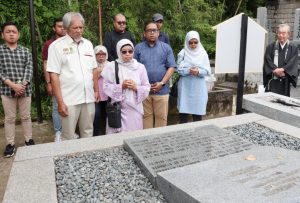Niece of Southern Special Student Yusof visits grave at temple in Hiroshima and expresses her intention to convey the story of his life in her homeland
Jul. 1, 2024
by Kyoko Niiyama, Staff Writer
The family of Nik Yusof, who died in the atomic bombing while studying at the Hiroshima University of Literature and Science (present-day Hiroshima University) as a “Southern Special Student,” paid a visit to Kozenji Temple in Saeki Ward, Hiroshima, where his grave is located. They heard about the circumstances in which remains were buried after the war and retraced his steps at the time.
Nik Mahizan, 63, is Mr. Yusof’s niece living in Malaysia. She recited the Quran with seven of her relatives in front of an Islamic-style grave erected on the temple grounds.
Mr. Yusof came to Japan in 1943 during World War II. When he was 19, he was exposed to the A-bombing in the students’ dormitory about 900 meters from the hypocenter. He suffered severe burns and escaped to the Itsukaichi area, but died there. Hiroshi Hoshizuki, 76, the former head priest of the temple, explained, “The cinerary urn was brought to the temple, and the head priest at the time built a grave to mourn his death. When Ms. Mahizan learned a memorial service is held on August 6 every year, she said she would like to thank the people who look after the grave.
The Southern Special Student program was established and funded by the Japanese government in an attempt to foster pro-Japan leaders. Ms. Mahizan learned of the existence of the grave through Nurhaizal Azam, a Malaysian-born associate professor at Hiroshima City University, and visited Hiroshima for the first time. She toured the Peace Memorial Museum in Naka Ward and visited Meiko Kurihara, 98, who stayed with international students after the A-bombing, at an A-bomb nursing home in Aki Ward.
Ms. Mahizan said her uncle was someone the family could not forget (her father had named her brother Yusof), and she wanted to tell the people around her what she had learned in Hiroshima after returning to Malaysia.
(Originally published on July 1, 2024)
The family of Nik Yusof, who died in the atomic bombing while studying at the Hiroshima University of Literature and Science (present-day Hiroshima University) as a “Southern Special Student,” paid a visit to Kozenji Temple in Saeki Ward, Hiroshima, where his grave is located. They heard about the circumstances in which remains were buried after the war and retraced his steps at the time.
Nik Mahizan, 63, is Mr. Yusof’s niece living in Malaysia. She recited the Quran with seven of her relatives in front of an Islamic-style grave erected on the temple grounds.
Mr. Yusof came to Japan in 1943 during World War II. When he was 19, he was exposed to the A-bombing in the students’ dormitory about 900 meters from the hypocenter. He suffered severe burns and escaped to the Itsukaichi area, but died there. Hiroshi Hoshizuki, 76, the former head priest of the temple, explained, “The cinerary urn was brought to the temple, and the head priest at the time built a grave to mourn his death. When Ms. Mahizan learned a memorial service is held on August 6 every year, she said she would like to thank the people who look after the grave.
The Southern Special Student program was established and funded by the Japanese government in an attempt to foster pro-Japan leaders. Ms. Mahizan learned of the existence of the grave through Nurhaizal Azam, a Malaysian-born associate professor at Hiroshima City University, and visited Hiroshima for the first time. She toured the Peace Memorial Museum in Naka Ward and visited Meiko Kurihara, 98, who stayed with international students after the A-bombing, at an A-bomb nursing home in Aki Ward.
Ms. Mahizan said her uncle was someone the family could not forget (her father had named her brother Yusof), and she wanted to tell the people around her what she had learned in Hiroshima after returning to Malaysia.
(Originally published on July 1, 2024)








